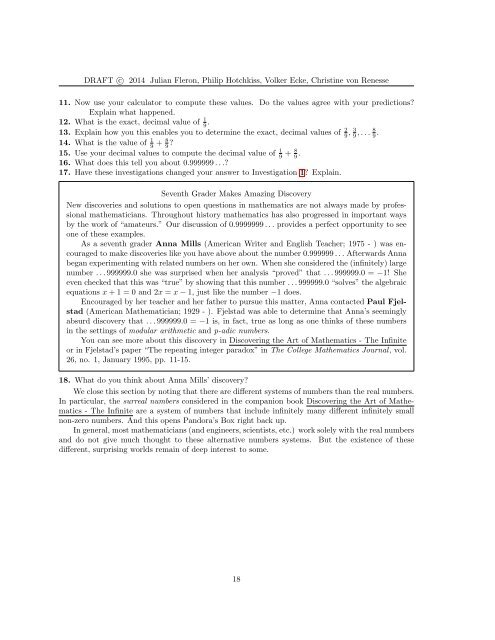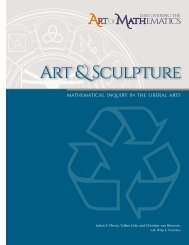calculus-2014-05-21
calculus-2014-05-21
calculus-2014-05-21
You also want an ePaper? Increase the reach of your titles
YUMPU automatically turns print PDFs into web optimized ePapers that Google loves.
DRAFT c○ <strong>2014</strong> Julian Fleron, Philip Hotchkiss, Volker Ecke, Christine von Renesse<br />
11. Now use your calculator to compute these values. Do the values agree with your predictions?<br />
Explain what happened.<br />
12. What is the exact, decimal value of 1 9 .<br />
13. Explain how you this enables you to determine the exact, decimal values of 2 9 , 3 9 , . . . 8 9 .<br />
14. What is the value of 1 9 + 8 9 ?<br />
15. Use your decimal values to compute the decimal value of 1 9 + 8 9 .<br />
16. What does this tell you about 0.999999 . . .?<br />
17. Have these investigations changed your answer to Investigation 1? Explain.<br />
Seventh Grader Makes Amazing Discovery<br />
New discoveries and solutions to open questions in mathematics are not always made by professional<br />
mathematicians. Throughout history mathematics has also progressed in important ways<br />
by the work of “amateurs.” Our discussion of 0.9999999 . . . provides a perfect opportunity to see<br />
one of these examples.<br />
As a seventh grader Anna Mills (American Writer and English Teacher; 1975 - ) was encouraged<br />
to make discoveries like you have above about the number 0.999999 . . . Afterwards Anna<br />
began experimenting with related numbers on her own. When she considered the (infinitely) large<br />
number . . . 999999.0 she was surprised when her analysis “proved” that . . . 999999.0 = −1! She<br />
even checked that this was “true” by showing that this number . . . 999999.0 “solves” the algebraic<br />
equations x + 1 = 0 and 2x = x − 1, just like the number −1 does.<br />
Encouraged by her teacher and her father to pursue this matter, Anna contacted Paul Fjelstad<br />
(American Mathematician; 1929 - ). Fjelstad was able to determine that Anna’s seemingly<br />
absurd discovery that . . . 999999.0 = −1 is, in fact, true as long as one thinks of these numbers<br />
in the settings of modular arithmetic and p-adic numbers.<br />
You can see more about this discovery in Discovering the Art of Mathematics - The Infinite<br />
or in Fjelstad’s paper “The repeating integer paradox” in The College Mathematics Journal, vol.<br />
26, no. 1, January 1995, pp. 11-15.<br />
18. What do you think about Anna Mills’ discovery?<br />
We close this section by noting that there are different systems of numbers than the real numbers.<br />
In particular, the surreal numbers considered in the companion book Discovering the Art of Mathematics<br />
- The Infinite are a system of numbers that include infinitely many different infinitely small<br />
non-zero numbers. And this opens Pandora’s Box right back up.<br />
In general, most mathematicians (and engineers, scientists, etc.) work solely with the real numbers<br />
and do not give much thought to these alternative numbers systems. But the existence of these<br />
different, surprising worlds remain of deep interest to some.<br />
18



